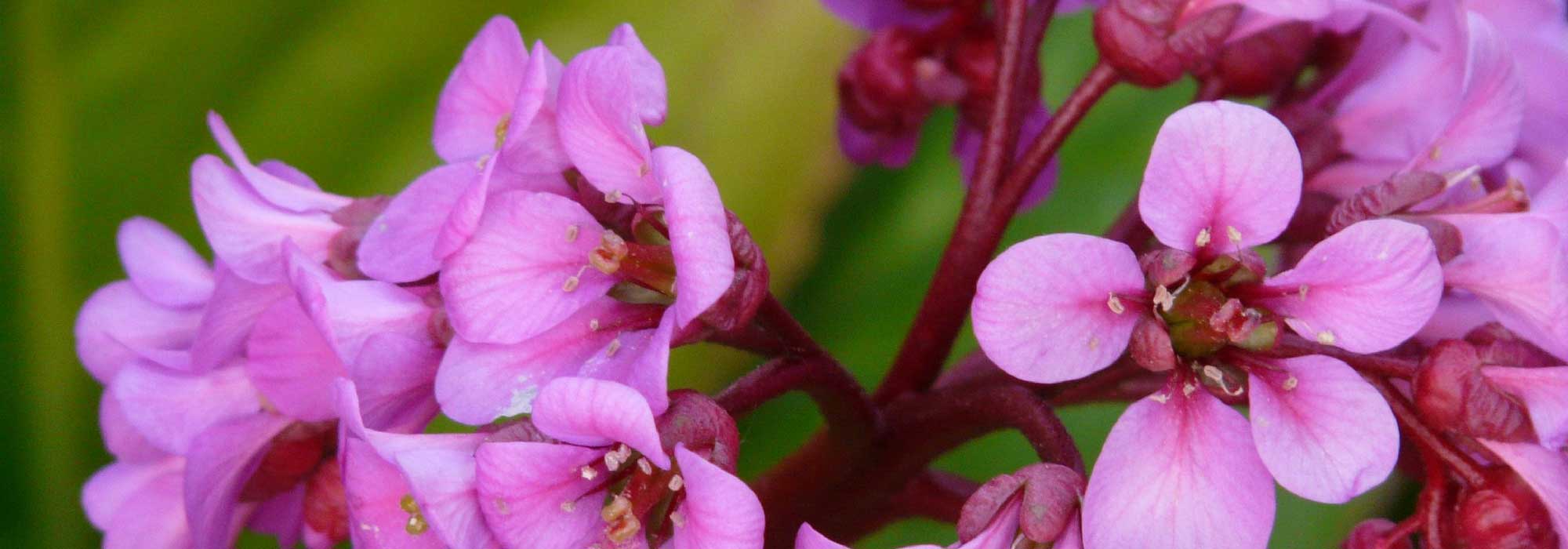
Bergenia, shoemaker's plant: planting, cultivation, maintenance
Contents
Bergenia in a nutshell
- Bergenia, known as “Shoe Maker’s Plant”, is one of the best ground cover plants for partial shade
- Its evergreen foliage remains impeccable all year round
- It is not afraid of cold or poor soils
- It has exceptional hardiness
- Easy to grow, it requires almost no maintenance
A word from our expert
The Bergenia, known as “Pigsqueak” or “Elephant Ears”, is one of the most exceptional evergreen perennial plants. Easy to care for and readily propagated, this generous, elegant, and compact perennial is making a strong comeback in our gardens.
It is a highly valued staple for its very attractive evergreen foliage, tough and changing, green with reddish hues in winter, and its stunning spring flowering, forming dense clumps of flowers that are often pink, white, or red. From late March with the earliest blooms to mid-June, they will brighten up the garden.
Red Bergenia, white Bergenia, or pink Bergenia, from Bergenia crassifolia to Bergenia purpurascens with its purple stems, and Bergenia cordifolia, the most common in our gardens, it always offers a charming display.
Beneath its appearance as a versatile plant lies an exemplary ease of cultivation and unmatched hardiness, all attributes that make it essential in every garden.
It thrives in non-burning sun or partial shade, in well-drained, even poor soil where it slowly forms thick floriferous carpets in rockeries as ground cover, or at the base of deciduous bushes.
If you are looking for a robust perennial that is always beautiful, fall for the Bergenia and discover our varieties of Bergenias!
Description and Botany
Botanical data
- Latin name Bergenia
- Family Saxifragaceae
- Common name Bergenia, pig's ears
- Flowering From February to June
- Height 0.20 to 0.60 cm
- Exposure Sun, partial shade
- Soil type All, well-drained
- Hardiness Below -15°
The genus Bergenia comprises around 8 species of evergreen rhizomatous perennials from the Saxifragaceae family. The Bergenia, also known as “pig’s ears”, is native to rocky heaths and cool undergrowth in Central and Eastern Asia, particularly the Altai Mountains in Siberia. In the wild, it only grows in snow-covered regions during winter.
The Bergenia cordifolia, a very hardy and robust species, is the most common in our gardens and has given rise to most cultivars and hybrids such as ‘Bressingham White’ or ‘Abendglut’.
Bergenia crassifolia has large, leathery leaves, while the Bergenia purpurascens is spectacular with its reddish stems.
This herbaceous perennial with a spreading habit grows in large, dense, creeping clumps forming a thick mat about 20 cm high and up to 70 cm in diameter at maturity, with a relatively slow growth rate. It develops slowly as ground cover, never becoming invasive.
Equipped with a short, thick, creeping rootstock, this plant spreads gradually, eventually forming beautiful flowering colonies over time.
Bergenia is highly valued for its ample green foliage, which reddens in the cold. It regenerates in spring. The short stems rise into a rosette of persistent, leathery leaves, glossy, oval, round, or heart-shaped at the base, with crinkled or slightly undulating edges. Supported by a sheathing petiole, they broaden into large, entire leaves, measuring 7 to 25 cm long and wide, sometimes referred to as “pig’s ears” or “elephant’s ears.” While most are glabrous, some, like Bergenia ciliata, bear pubescent leaves covered with numerous hairs.

From left to right: Bergenia ‘Baby Doll’, foliage of Bergenia ‘Abendglut’, Bergenia ‘Morgenrote’.
With a beautiful bright green to dark green top, this foliage, sometimes marked with reddish veins, is often purplish-red underneath. Remaining lush and green for a good part of the year, they turn in autumn and winter to shades of purple-red, beet-red, and bronze.
Bergenia offers a superb early flowering, sometimes slightly fragrant. From late winter to early spring, numerous flower spikes emerge well above the foliage. The flower buds, encased in a thick brown-pink or reddish calyx, are borne on hairy, sturdy stems that are light brown to purplish-red.
Grouped in dense panicles of pendulous flowers at the tips of these branched stems, they stand upright as they bloom. They open into clouds of small bell-shaped flowers with five petals, measuring 1 to 3 cm in diameter, white, lilac magenta, soft pink to crimson or purple. Some, double or semi-double, resemble those of a Japanese cherry tree. They will compose fresh spring bouquets. The flowering may renew itself when summer is cool.
Very easy to cultivate, Bergenia tolerates many conditions. It grows in shade, partial shade, or gentle sun in any type of soil, whether poor, calcareous, or rich, provided it is always well-drained and cool. Hardy and robust, it fears neither cold nor snow and can withstand extreme temperatures down to -35°C to -45°C.

A flower of Bergenia cordifolia visited by a hoverfly.
It is an excellent ground cover, ideal for covering a slope, dressing a rockery, or the base of deciduous trees or shrubs. It can be planted in groups, in a deciduous woodland or in shrub borders with primroses, spring bulbs, heucheras, and oriental hellebores, and hostas.
Main species and varieties
Le genre Bergenia ne compte qu’une petite dizaine d’espèces. A côté du Bergenia cordifolia, le plus courant dans nos jardins et son célèbre cultivar ‘Purpurea’, aux fleurs magenta pourpré, on trouve aussi le Bergenia crassifolia et le spectaculaire Bergenia purpurascens aux tiges, aux fleurs et aux feuilles pourprées. Les Bergenias hybrides comme ‘Abendglut’, ‘Bressingham White’ et ‘Wintermärchen’, complètent un choix essentiellement guidé par les coloris somptueux des feuilles et des fleurs allant du blanc pur au rose vif carminé.
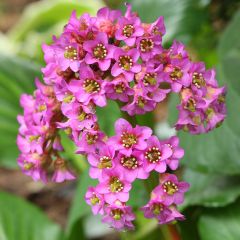
Bergenia cordifolia - Elephant's Ears
- Flowering time April to June
- Height at maturity 40 cm
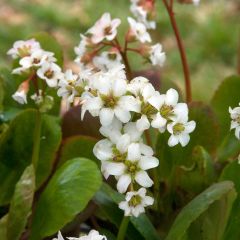
Bergenia Bressingham White - Elephant's Ears
- Flowering time June, July
- Height at maturity 30 cm
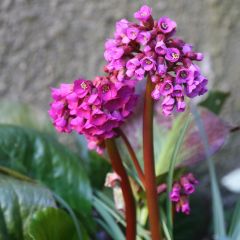
Bergenia purpurascens - Pigsqueak
- Flowering time April, May
- Height at maturity 30 cm
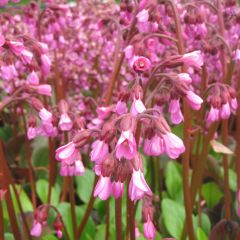
Bergenia Wintermarchen - Elephant's Ears
- Flowering time May, June
- Height at maturity 40 cm
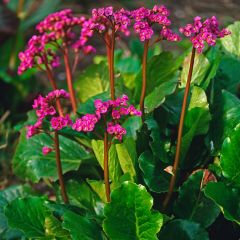
Bergenia cordifolia Morgenrote - Elephant's Ears
- Flowering time April to July
- Height at maturity 40 cm
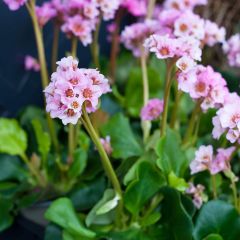
Bergenia Baby Doll - Elephant's Ears
- Flowering time May, June
- Height at maturity 25 cm
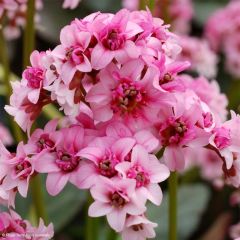
Bergenia Dragonfly Series Sakura - Elephant's Ears
- Flowering time April, May
- Height at maturity 25 cm
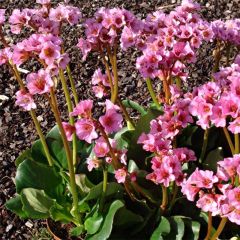
Bergenia Rosenkristall - Elephant's Ears
- Flowering time March, April
- Height at maturity 40 cm
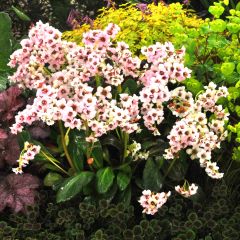
Bergenia Dragonfly Series Angel Kiss - Elephant's Ears
- Flowering time May, June
- Height at maturity 30 cm
Discover other Bergenia
View all →Available in 0 sizes
Available in 3 sizes
Available in 1 sizes
Available in 1 sizes
Available in 2 sizes
Available in 1 sizes
Available in 2 sizes
Available in 1 sizes
Available in 2 sizes
Available in 1 sizes
Plantation
Where to plant Bergenias
Bergenia is a truly low-maintenance plant. It settles in all regions, except perhaps in Mediterranean climates, which can be a bit too dry in summer. It should be protected from strong sunlight and very dry soils, which tend to halt its growth.
Cold, on the other hand, does not scare it. From its Himalayan origins, it has retained a lovely hardiness, capable of withstanding very low temperatures down to -35 °C. It is a versatile plant that tolerates salt spray as well as pollution in urban gardens.
Accommodating, it accepts all exposures and grows in any soil, preferably cool.
When planted in poor soil, the magnificent colours of its foliage, ranging from green to red and bronze, will be enhanced throughout the winter. It will thrive better in cool, humus-bearing, well-drained soil. Heat does not bother it as long as the soil remains cool.
It is most beautiful in partial shade, although it will also do well in non-burning sunlight. Too dense shade hinders its flowering, and overly rich soil will favour foliage at the expense of flowers.
Useful, this ground cover limits the proliferation of weeds. It is the perennial of choice for covering a shaded bank that requires no maintenance.
It can be used in pots, in rockeries, along borders, or at the foot of deciduous shrubs that will protect it from summer heat, where it will eventually (when planted in groups of 3 or 5) form vigorous, floriferous clumps.
When to plant Bergenia
Planting Bergenia is preferably done in spring, in March-April or May, after the frosts, or from September to November in mild climates.
How to plant a Bergenia
The soil must be well loosened to plant Bergenia. Slow to establish, once well settled after two years, it offers a lovely longevity accompanied by increasingly generous flowering. It likes soil that remains cool during summer, especially in the first few years (as it ages, it will tolerate drought better) but well-drained.
Space the plants 30 to 40 cm apart to allow the clumps to flourish comfortably. Count 5 to 6 buckets per m², given the beautiful development of this perennial, this allows for a lovely effect.
Consider planting a few small spring bulbs (Galanthus, Crocus, Chionodoxa…) between two Bergenia plants to fill the space until they reach ripeness.
- Clear the soil of stones, roots, and weeds
- Loosen the soil well, work the earth thoroughly
- Dig a hole 2 to 3 times the volume of the pot
- Plant it in a mixture of well-decomposed compost and garden soil
- Water regularly for the first six weeks to encourage rooting
- Mulch in spring to keep the soil cool at its base with a pine bark mulch
- In spring, protect its young shoots from snails and slugs; if necessary, use fern manure to combat their attacks
→ Discover our tips on growing Bergenia in pots in our advice sheet
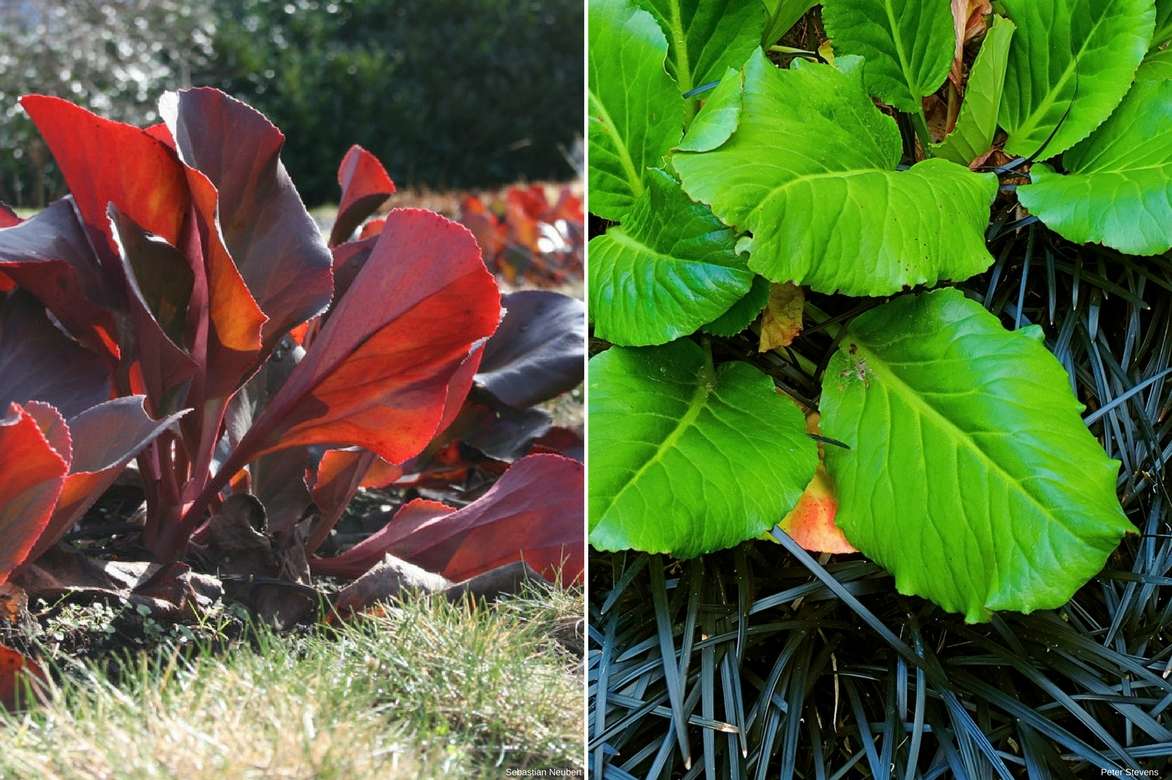 From left to right: Stunning red foliage of Bergenia cordifolia ‘Amiral’ – Foliage of a Bergenia associated with Ophipogon planiscapus ‘Nigrescens.</caption]
From left to right: Stunning red foliage of Bergenia cordifolia ‘Amiral’ – Foliage of a Bergenia associated with Ophipogon planiscapus ‘Nigrescens.</caption]
Care, pruning and maintenance of Bergenia
Bergenia requires virtually no maintenance and proves to be a hassle-free perennial with robust health. It can live for many decades without any care, as long as the soil remains well-drained and cool in summer. Easy to grow and generous, it fears neither cold nor snow, which provides excellent protection for its leaves.
While Bergenia easily adapts to all types of soils, it does not tolerate overly dry soils very well. Water regularly once or twice a week during the first summer following planting. Then, water during heatwaves to ensure the soil remains consistently cool. Apply a good layer of mulch before spring, especially in the first few years after planting.
Pruning is not necessary; however, a light spring clean can be beneficial. In March, remove all old, dry or blackened leaves. Remove faded leaves as needed.
Cut back the flower stems just after flowering to enhance the foliage.
Even though it is content with fairly poor soil, adding organic compost in early spring accelerates its growth and encourages flowering.
Diseases and potential pests
Well established in well-drained soil, Bergenia proves to be very resilient.
Little susceptible to diseases, it has only a few rare enemies: slugs at the start of the growing season and weevil larvae when grown in pots.
When grown in pots, its rootstock and roots can be devoured by weevil larvae. Spray a nematode-based solution in spring, which you can find at specialist garden centres. The nematode, a microscopic worm, will parasitise the weevil larvae, which will be consumed within a few weeks. In the garden, weevil larvae do not pose a problem as they are eaten by a large number of beneficial animals, including birds and hedgehogs.
Occasionally, leaf spots may appear due to fungal diseases. To prevent them, plant your bergenias in a way that allows for sufficient air circulation, adhering to the recommended planting distances. Removing spotted leaves is crucial to prevent any spread. As a preventive measure, regularly carry out sprays of horsetail or nettle manure.
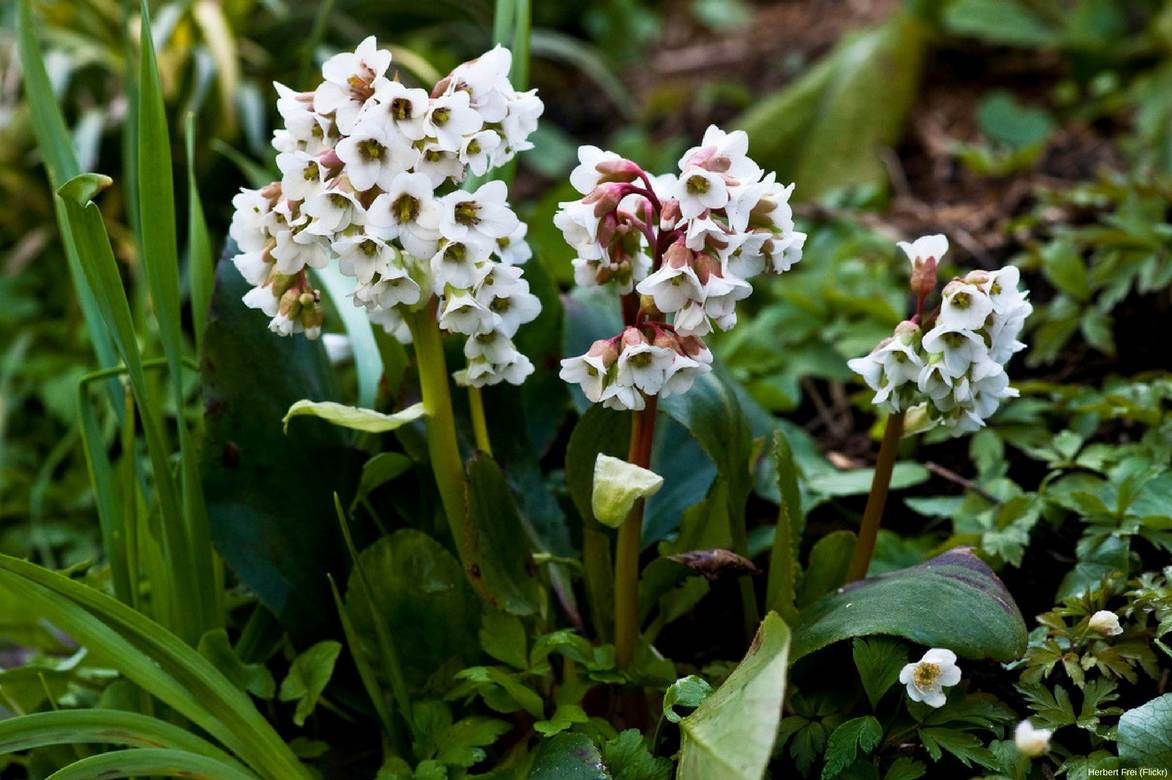
The delightful pure white bells of Bergenia ‘Bressingham White’.
Multiplying bergenias
The Bergenia can be easily divided. Over the years, the plant may show signs of fatigue and a sparser flowering: after 4-5 years, in spring or autumn, divide the largest stumps that are at least three years old to rejuvenate the plant and maintain beautiful flowering.
- Using a spade, take a rootstock from the edge of the clump that has a rosette of leaves
- Immediately replant the rootstock pieces in well-worked soil in the garden
Associate
The Bergenia proves to be essential in a wooded garden. Spring-flowering perennials such as perennial geraniums, cyclamen coum, early crocuses, winter heathers, snowdrops, and winter aconites are its favourites.
In a flowerbed, it will look wonderful paired with early flowering daffodils and other spring bulbs.
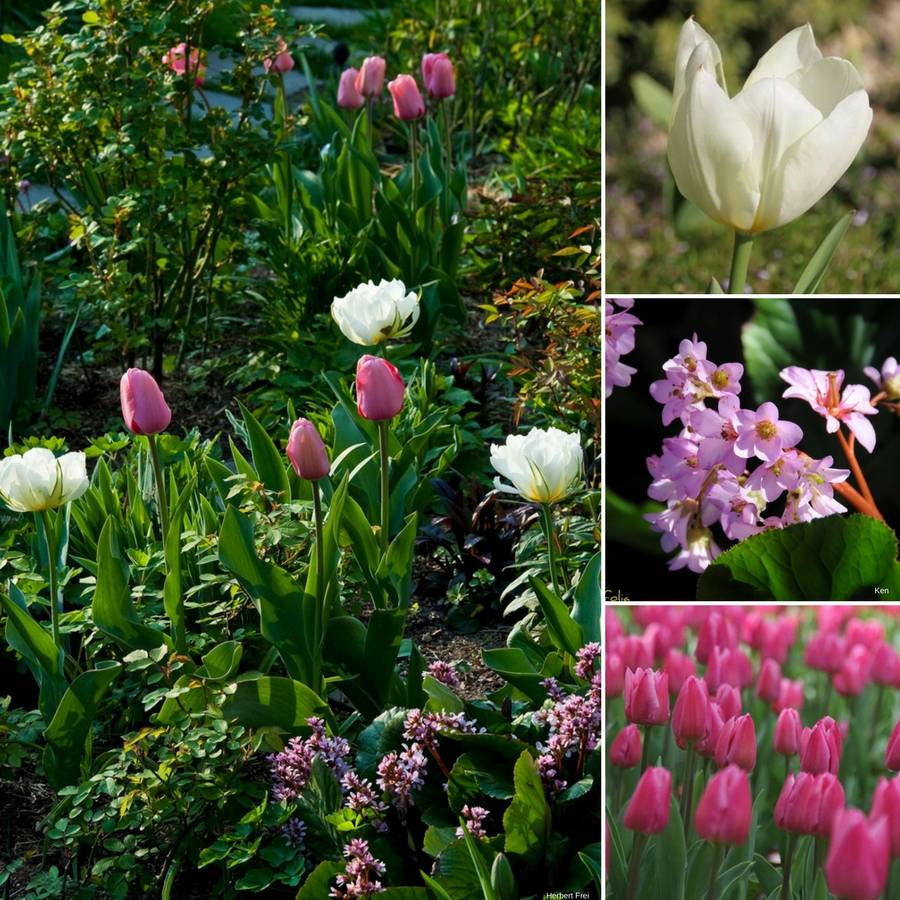
A spring combination idea: Bergenia cordifolia is paired with early tulips such as T. ‘Christmas Dream’ and T. fosteriana ‘Purissima’.
It can be planted in the foreground of plants with a fairly loose habit such as asters or phlox, which will spread above its foliage for a good part of the year.
To cover a slope, it will pair perfectly with creeping bugle, hepatica, primroses, and in light woodland, with epimediums, and oriental hellebores.
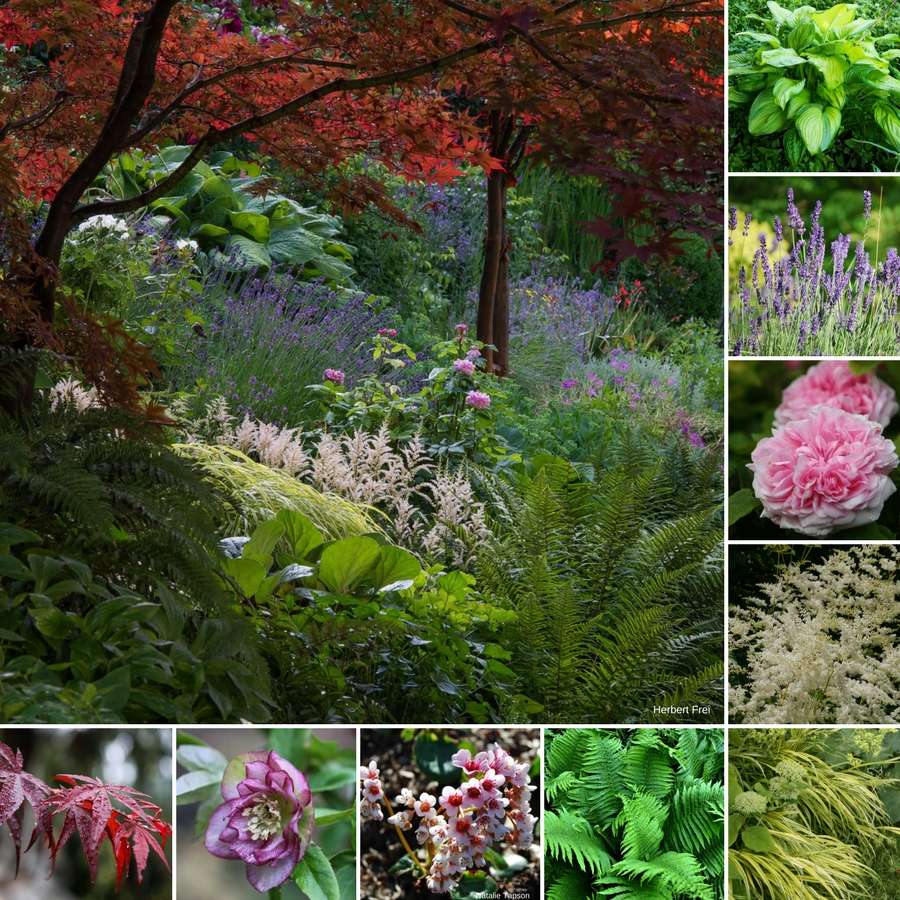
An example of a combination for a partially shaded slope: Acer palmatum ‘Atropurpureum’, Helleborus orientalis, Bergenia ciliata, Dryopteris filix-mas, Hakonechloa macra ‘Aureola’, Astilbe simplicifolia ‘Sprite’, Rosa ‘Jacques Cartier’, Lavandula, Hosta ‘Guacamole’.
In rockeries, in light shade, it will also pair well with heucheras, hostas, and small evergreen shrubs such as euonymus and winter-coloured dogwoods.
You can combine it with foliage that contrasts in shape, grasses, carex, stipas, or even ferns.
Useful resources
- Discover the new bergenias, some of which are exclusive
- Explore our selection of the 6 most beautiful varieties of Bergenia
- Choose spring-flowering perennials to accompany your bergenias
- Our advice sheet: 6 Bergenias with pink flowers
- Our advice sheet: How to grow a Bergenia in a pot?
- Our advice sheet: How to choose a bergenia?
- Our advice sheet: Diseases and parasites of bergenia
- Our advice sheet: 7 Bergenias with beautiful autumn colours
- Discover 6 perennials flowering at the end of winter
Frequently asked questions
-
Why isn't my Bergenia flowering?
Bergenia is a generous perennial that is usually very floriferous. A bergenia that does not flower is likely planted in soil that is too rich or exposed to too much shade. Dense shade hinders its flowering; it needs sunlight to bloom well.
- Subscribe!
- Contents































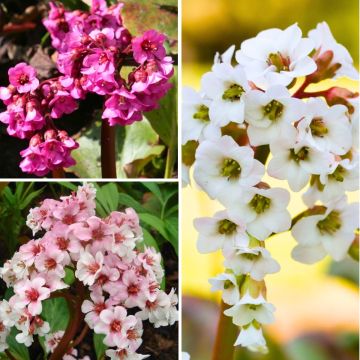

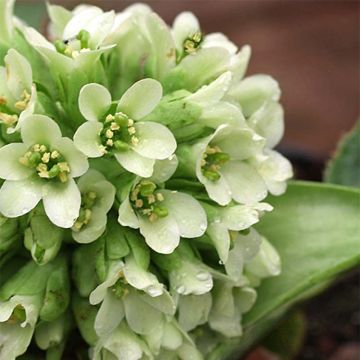
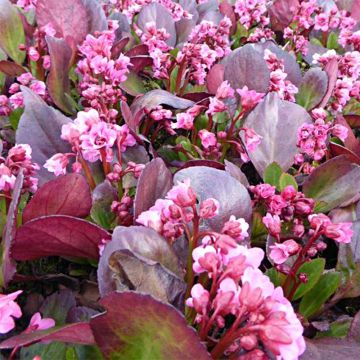

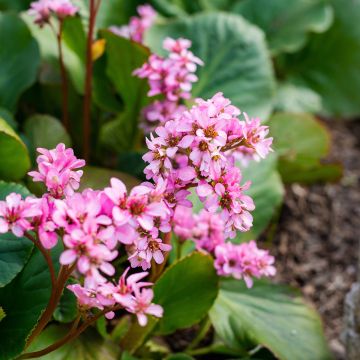
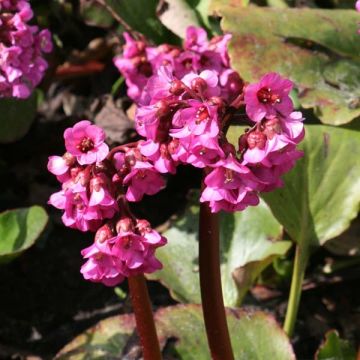
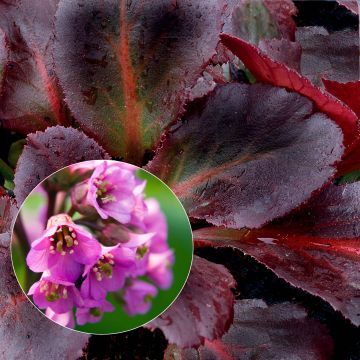
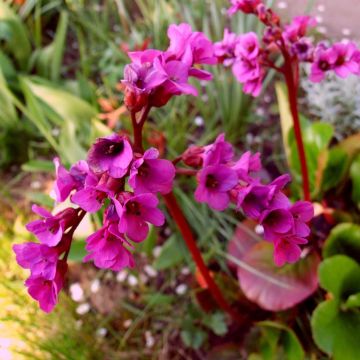
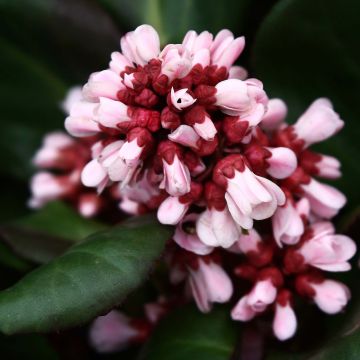
Comments